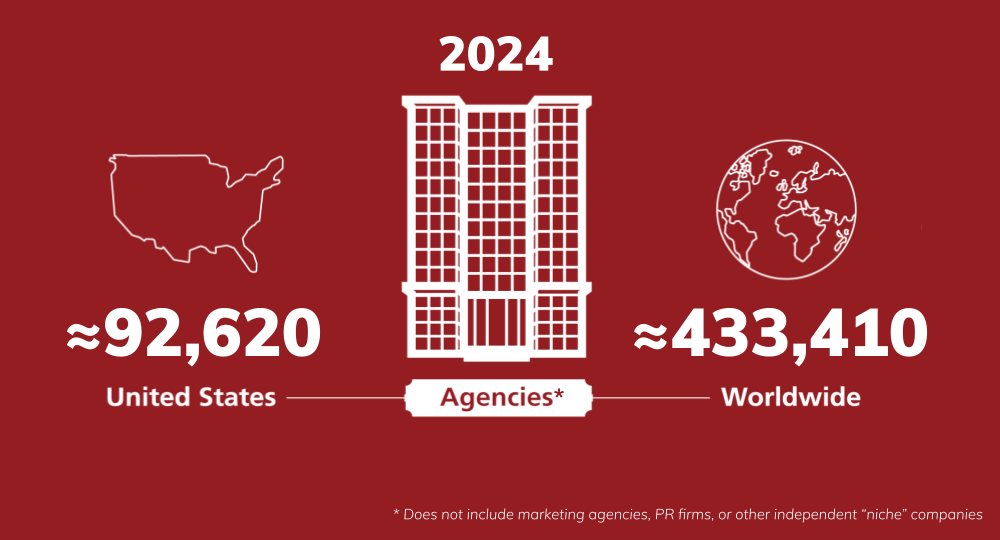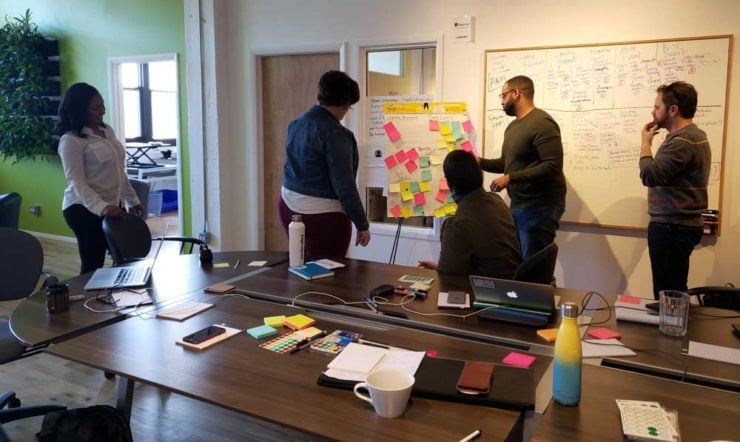How to Improve Your Digital Supply Chain

Here are eighteen ways you can use ESG practices to improve your digital supply chain. We also share why this matters and what we’ve learned through our own experience.
Do digital marketers and product teams have supply chains? They sure do. An effective digital supply chain can help you improve efficiency and sustainability, reduce costs, streamline operational processes, and reach your business goals faster.
However, mismanaged digital supply chains can wreak havoc across your entire organization and drive multiple business and marketing challenges. Unfortunately, this is one of the most common client problems we see at Mightybytes. Here’s an example.
When Bad Digital Decisions Sabotage Good Organizations
We recently started working with a new client who hired us to take over managing their organizational websites. Auditing these websites revealed some significant challenges:
- Obsolete server software posed potential security risks and couldn’t be updated without a major structural overhaul.
- An outdated CMS with an inflexible page builder required significant workarounds just to publish and manage content.
- 90+ plugins, many of which were either outdated or not in use, added further security risks and workflow issues.
- Several third-party software integrations made managing events and organizational data challenging. Some of these ‘off-the-shelf’ solutions had been significantly customized, meaning they couldn’t be updated, adding more security risks.
- A massive media library posed migration problems and ballooned hosting costs.
Because of these issues—many of which originated from third-party suppliers—the sites couldn’t be migrated, updated, or enhanced in any meaningful (or affordable) way. Efforts to do so resulted in crashes and errors.

The Consequences of Unfit Tech
The list above challenged the organization’s ability to meet its goals and posed considerable problems:
- User experience: A compromised user experience frustrated the organization’s members and website users overall, leading to increased abandonment rates and ongoing complaints.
- Admin workarounds: Site admins wasted resources on time-intensive workarounds and troubleshooting bugs instead of efficiently managing data and content.
- Security: Unstable or outdated software increased the risk of site hacks and data breaches, which could result in large fines from violating data privacy laws.
- Sustainability: With thousands of monthly website visitors, the sustainability ramifications of these problems were potentially significant.
- Cost: What’s more, these issues cost the organization thousands of dollars every month—with little to show for it.
From every angle, this was an unsustainable situation. Worst of all, when the organization approached their agency vendor about how best to address these issues, they couldn’t get straight answers or a clear path forward. This left them in an untenable position.
Unfortunately, this organization is now faced with the potentially expensive decision to dump their website investment and start over. If you’ve been in this or a similar situation you know how painful and frustrating it can be. But it didn’t have to be this way.
Supply Chain Decisions and Your Success
There’s a direct correlation between an organization’s success and its relationship with third-party digital products and services—and the vendors that provide them. Scenarios like the one described above typically happen for multiple reasons. Here are two that we run into over and over again:
- A lack of effective digital governance policies for managing third-party providers over time
- Poor agency partner choices in their supply chain.
The consequences of decisions related to these two things can impact every level of your organization. We cover various governance topics extensively on this blog, including content governance and data governance. These are critical components of good Corporate Digital Responsibility (CDR) practices and key to organizational success. For the purpose of this post, we focus on supply chains, specifically digital supply chains.
What’s a Digital Supply Chain?
[A] digital supply chain includes the website’s developers, its administrators, the cloud services company that hosts the website’s data, the CMS provider, and the devices that consumers use to access the website. In addition, every third-party technology provider whose code provides functionality to the website — e-commerce plugins, personalized recommendation engines, advanced analytics services, inventory tracking solutions, custom product builder, chatbots, etc. — should also be considered part of the digital supply chain.
— Bitsight, What is Digital Supply Chain Management?
Your digital supply chain consists of the external partners you use to run and manage digital products, services, and data within your organization. Digital supply chains are a complex and often tangled ecosystem of people, products, and processes.
From marketing and advertising agencies to website plugins and software subscriptions, these external resources have a critical impact on your organization’s success. Also, managing the relationships associated with these accounts over time can be resource-intensive, depending on the size or complexity of your organization.
Yet many organizations tend to take their digital supply chains for granted or underestimate the resources needed to effectively manage them.
We see well-meaning marketers and product leaders quickly string together third-party digital products and services without considering long-term consequences. It’s reactive decision-making based on cost and immediate technology needs versus intentional, long-term strategic planning.
Over time, they end up with a digital marketing ecosystem that’s held together by the virtual equivalent of Band-Aids, dental floss, and chewing gum. And that’s when the real problems begin.
Let’s look at several ways you might address these digital supply chain challenges.

Interdependence: Finding Good Partners
Many firms face challenges because of the brokers or agents that sit between them and their customers. This makes it difficult to acquire and maintain customer data and makes it difficult to understand or manage the customer experience.
— Peter Bendor-Samuel, Digital Platforms Must Meet Needs Of All Stakeholders, Not Just Customers
Organizations rely upon partners to help them effectively meet their goals. Identify the right supplier fit for your organization based on this interdependence. Ground these relationships in purpose, trust, and the partner’s ability to execute necessary tasks. Ideally, third-party partners should:
- Align with your organization’s values to reduce risk
- Share a commitment to providing excellent stakeholder experiences
- Be willing to jointly build mutually beneficial strategic partnerships over time
Beyond customers or users, common third-party stakeholders in a digital supply chain can include:
- Service partners like marketing or advertising agencies, SEO firms, and so on
- Product partners, including software subscriptions, email marketing platforms, and the like
- White label providers of website plugins, hosting, CRM, ecommerce, or similar services
Let’s break these down in more detail, including the benefits and risks associated with each.
Service Partners
An agency relationship can make or break your organization. Good service partners help you meet your goals quickly and efficiently, then set you up for long-term, continued success. Bad partners…well, they just don’t.
Potential benefits:
- An on-call resource whose job it is to help you understand industry trends, new developments, changing best practices, and so on
- Reduces risk and increases stability
- Improves performance over time; reach goals faster
- Helps you build capacity as an extension of your own team
Potential risks:
- Constant upselling or hidden costs; could get expensive
- Poor communication or bad customer service
- Doesn’t stay on top of maintenance tasks like they should
- Held hostage by your contract, especially problematic with RFPs
- Not aligned with your values
It is important to create and nurture agency relationships based on trust and mutual respect. When done right, shared success is assured.
Product Partners
Often offered as software subscriptions, these partners can help you cost-effectively add new features, expand service offerings, and build capacity while keeping overhead low. However, the subscription model doesn’t foster meaningful personal relationships, which can undermine long-term success. Plus, each addition also has sustainability ramifications, something to keep tabs on.
Potential benefits:
- Help you streamline and automate common business tasks
- Access to meaningful business metrics that might be cost-prohibitive otherwise
- Build organizational capacity
- Potentially reduce short-term costs
- Easy to change as your business needs do
Potential risks:
- Possible data breaches
- Ongoing costs never go away and typically increase over time
- Product training can be insufficient
- Poor customer service
- Too many subscriptions can become unwieldy
- Hard to find public-facing commitments to important issues like sustainability or accessibility
- Other unintended consequences
The right software partners can bring many long-term benefits to your organization. Values alignment is key. Unfortunately, very few digital products and service companies have clear, public-facing sustainability or social justice commitments. However, with mandatory ESG (Environmental/Social/Governance) disclosures on the horizon, this will change quickly, especially for larger companies.
White Label Solutions
This option combines the other two above. It is not uncommon for service partners like agencies to offer ‘white label’ software packages from third parties as part of their own offerings. This can be useful for organizations that want a one-stop solution. However, it comes with several drawbacks too.
Potential benefits:
- Bundled: everything in one place
- Someone else manages the details so you don’t have to
- Can be cost-effective
- Enables you to focus on running your business
Potential risks:
- You lose control over third-party accounts and relationships
- Transition can be confusing and challenging if you move away from a partner that white labels solutions from other companies
- Poor subscription management from the agency partner leads to service loss
- Lack of transparency regarding white labeling leads to service loss
Agencies committed to building mutually beneficial relationships can make this approach very successful for your organization. However, transparency and trust are key. Without those elements, things can fall apart quickly.
This year, we’ve been on a journey to define a sustainable marketing stack—a set of digital products and services marketers can use to help them run effective campaigns while also prioritizing people and planet. If your agency partner white labels third-party products or services, ask if they use any of the companies listed in the link above.

18 ESG Tactics to Reduce Risk and Improve Your Digital Supply Chain
A company’s impact extends far beyond its own walls. Purchasing and supply chain programs can promote inclusion in many ways, from ensuring the most vulnerable populations around the world have their human rights preserved to taking proactive measures to support transformative and purpose-driven companies.
— B Lab, Creating Impact through Purchasing: Managing the Impact and Inclusion of Your Supply Chain
ESG provides a great lens through which to address many of the digital supply chain issues mentioned above as well as specific environmental, social, and economic challenges associated with managing digital products and services over time. Plus, many of the recommendations below will help you build stronger, more interdependent relationships with supply chain partners.
As climate reporting and disclosure legislation spreads, it will become increasingly important to align your entire business ecosystem with ESG practices. Current regulations primarily focus on investment risks for larger companies. However, over time these practices will extend to organizations of any size and in any industry or sector. It makes good business sense to get ahead of the curve.
To implement the eighteen tactics suggested below, list out third-party providers your department or organization utilizes for sales, marketing, communications, and technology initiatives. Include service partners, like agencies, plus any free or paid software, online communities, social networks, or other digital platforms that you subscribe to. If you have access to white label solutions, that will be helpful too.
Not sure where to start? This stakeholder mapping workshop can help you better understand the players in your business ecosystem.
Environmental Tactics
Starting with the ‘E’ in ESG, these four recommendations can help you forge new or enhance existing supplier relationships through shared commitments to improving environmental performance.
1. Audit third-party providers based on public-facing environmental commitments
First, identify whether your partners or suppliers have published sustainability statements or any clear environmental goals or commitments in a public-facing place, like their website.
2. Encourage current partners to change their practices
If a partner or provider doesn’t have public-facing commitments to improve environmental performance, might they consider making some? It can’t hurt to ask. Offer to help them along their journey, especially if they’re just getting started.
3. Partner on joint sustainability and emissions reduction projects, especially Scope 3
Up to 90% of Scope 3 emissions can be produced in an organization’s supply chain. Work with your partners to promote data transparency and share resources on sustainability efforts, including reporting and digital emissions.
Related resource: Read Scope 3 Emissions in Your Digital Supply Chain.
4. Reduce your third-party technology footprint
Outdated or unused files, media, plugins, or other digital artifacts take up server space, wasting electricity and other resources. Plus, outdated files increase security risks. Many of these files exist under third-party provider accounts, some of which offer auto-deletion and expiration features to help you improve sustainability, reduce resources (and, potentially, costs), and use less server space.
Related resource: Try the Digital Declutter Toolkit from Business Declares and Wholegrain Digital.
Social Tactics
Improve the social aspects of digital products and services by focusing on inclusion, accessibility, and community impact with third-party partners.
5. Choose partners based on a public facing Code of Ethics
Has a potential vendor partner published a Code of Ethics on their website or other public-facing location? This document serves as an overarching declaration of the organization’s ESG practices and policies. When searching out values-aligned partners, be sure to ask specifics about how they implement these practices.
6. Prioritize accessibility and community impact with third-party providers
Up to 20% of the world’s population identifies as having some sort of physical or cognitive disability, including many of your customers and suppliers. Create meaningful partnerships grounded in a shared agreement to prioritize these stakeholders’ needs as well as those of other important communities within your business ecosystem.
Related resource: How Web Content Accessibility Guidelines Improve Digital Products
7. Supplier JEDI commitments
Have your partners made commitments to improve Justice, Equity, Diversity, and Inclusion (JEDI) within their organization? Look for social equity certifications like LGBTBE, WBE, or other minority-owned supplier designations as well as public-facing claims on websites or social profiles about specific campaigns or practices.
Related resource: Client, Partner, and Supplier Screening Tools for Positive Impact Supply Chains
8. Living wage check for suppliers
When vetting potential partners, ask about their commitment to paying a living wage. What is the pay ratio between the highest and lowest paid employees? If they can’t easily answer these questions, are they the right choice for you?
9. Transparency with third-party and white label providers
If suppliers white label third-party subscriptions on your behalf, make sure they are transparent about what happens if the relationship ends. Many an organization has been left high and dry when they sever an agency partnership, then suddenly their website or plugins no longer work.
Better yet, set up dashboards to track performance over time across these providers. In the future, digital product passports could prove an easy and effective way to manage this information.
10. Fight mis/disinformation
Misinformation (accidentally sharing untruthful information) and disinformation (intentionally sharing untruthful information) are at epidemic proportions on the internet. This undermines social systems and is exacerbated by the rapid rise of AI. Choose partners committed to combating these problems and engage with them to jointly support responsible legislation in this area.
Related resource: Understanding Social Digital Responsibility
11. Data privacy and protection
Data privacy laws are increasing rapidly around the world. Work with providers to prioritize data privacy, data ownership, and users’ ‘right to be forgotten’. Make sure you and your partners agree on a shared definition of ethical practices.
Related resource: Data Privacy Checklist
Governance Tactics
Your organization’s policies and practices can make the most impactful difference in improving supplier relationships and creating shared value.
12. Impact economy purchasing policy
Create organizational policies that support the Impact Economy. Buy first from B Corps, Fair Trade, and related organizations. Buy next from suppliers with public facing commitments like those included in this list. Resort to traditional suppliers only when you can’t find a values-aligned partner. They’re out there. It just might take a bit more effort to find them.

13. Nurture good collaboration practices
Next, be intentional about how you will solve problems together with third-party partners. Well-planned collaborative workshops can serve as a cost-effective way to quickly build consensus and make progress against your goals. In-person meetings are preferred, at least as you’re getting to know new partners. However, virtual tools have come a long way. Either way, schedule these as frequently as makes sense when working on long-term digital projects.
Related resources: Seven Tips for Better Creative Collaboration or Design Sprints for Social Impact Projects
14. Supplier development
Similarly, incentivize partners based on shared goals and strategic commitments to mutual success. Be sure to include regular relationship check-ins, project retrospectives, and ongoing performance reviews. Don’t be afraid to talk about the hard stuff!
Related resource: Five Communications Processes to Improve Digital Projects
15. Shift to continuous improvement
Few projects are ever done. Most require ongoing refinement to meet or improve upon your goals. This is especially true in digital. Building consensus on clear key performance indicators (KPIs) for continuous improvement with third-party providers will make a huge difference here. This will also help you maintain software and third-party accounts over time, reducing security risks and improving digital resilience.
Related resource: Product Management and the Build Trap
16. Responsible automation and outsourcing
Third-party suppliers often automate existing internal processes. Be sure to upskill and cross-train internal stakeholders when looking to outsource or automate business processes with external partners.
17. Clear yet flexible contracts
Provide enough detail to manage expectations and responsibilities in legally binding contracts, but don’t over-engineer them to be too restrictive. A Master Services Agreement (MSA) that governs the relationship plus Statements of Work to govern individual deliverables will allow for enough flexibility if you need to change scope or otherwise pivot from your original game plan. Also, stay away from RFPs.
Related resource: RFPs are Not a Sustainable Business Practice
18. Advocate for responsible tech legislation
Some of the items above won’t change unless regulations require organizations to change them. Reserve time and resources to advocate for more responsible tech legislation. Educate your representatives on why these issues are important and encourage them to introduce or vote on bills that prioritize ESG practices.
Next, go beyond digital
Finally, while this post focuses on third-party digital products and services, we would be remiss if we didn’t mention that these principles also apply to the non-digital components of an organization’s business ecosystem. For example:
- Do you bank with a values-aligned financial institution?
- Who do you partner with for organizational benefits?
- Which physical products and services could be improved based on the recommendations in this post?
- And so on…
For a great resource on the power of purchasing to create positive impact, check out B Lab’s playbook, Creating Impact Through Purchasing: Managing the Impact and Inclusion of Your Supply Chain (PDF).
Sustainable Change Requires Effective Partnerships
You can’t expect to transform your organization in any meaningful way without good partners and policies to support the changes required. Find partners who are willing to commit to shared prosperity that is durable and grounded in interdependence, mutual respect, and trust. Nurture these relationships using the tactics in this post. The results will be worth the effort.
As always, feel free to reach out if you have any questions whatsoever.



